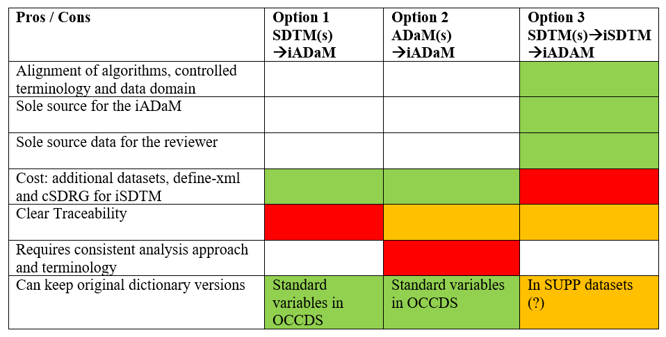The Integration Dilemma


As of today, our Industry has not defined any approach, nor does an official regulatory agency preference/recommendation exists on how to integrate data of different studies to support either an Integrated Summary of Safety (ISS) or an Integrated Summary of Efficacy (ISE).
Only last October, PHUSE released a white paper, “Integration Strategies in Support of ISS/ISE Submissions” [1], where three integration approaches are proposed and the pros and cons are discussed:
- SDTM(s) iADaM: ADAM Integration only Using Individual Studies SDTM datasets
- ADaM(s) iADaM: ADAM Integration only Using Individual Studies ADAM datasets
- SDTM(s) iSDTM iADaM: SDTM and ADAM Integration
Furthermore, a recent PHUSE webinar covered the three integration approaches [2]; two FDA representatives were also a part of this panel.
All three integration options require the creation of an iADaM from which integrated analyses are generated. While in Option 1, iADaM is generated from individual study SDTM(s) and in Option 2 individual study ADaM(s) is used, Option 3 requires an intermediate set of SDTM datasets (iSDTM) to be created from individual study SDTM(s), from which iADaM is then generated.
In all three scenarios, it is also accepted to integrate either legacy raw datasets or legacy analysis datasets directly into either iSDTM or iADaM for studies started before or on December 17, 2016. This reduces the effort and budget needed when dealing with submissions with several old studies yet to be integrated.
Which option should you choose?
During the PHUSE webinar, the participants were asked to reveal which approach they commonly used for Integrating their studies, surprisingly (to me), their top preference was Option 2 (53%), followed by Option 3 (32%); Option 2 also appeared to be the preferred choice of the two FDA representatives although, it was recognized that Option 3 too is a valid option under certain circumstances, provided that traceability is guaranteed.
In all cases, rationale for the approach used should be mentioned in the reviewer guide, either in the Integrated Clinical Study Data Reviewer Guide (icSDRG) or in the Integrated Analysis Data Reviewer Guide (iADRG). Most importantly, it should be discussed when meeting the relevant agency prior to pre-NDA/BLA meeting, for example, during a type-C meeting (planned integration strategy can be anticipated in the Study Data Standardization Plan – SDSP [3]).
As mentioned above, Option 2 seems to be the preferred choice of the Pharma Industry Community and the FDA. However, after evaluating all the Pros and Cons (see table below), Option 3 is still my preferred approach as it provides better traceability, although you might say that with Option 2 you can assume traceability was already done from individual SDTMs to individual ADaMs. Option 3 is my recommended option because it provides a sole source for the iADaM and a sole source for the reviewer, after integrating and harmonizing data from all concerned studies (harmonized controlled terminology, one single version of medical dictionary, etc.). However, this option will require the reprogramming of endpoints, variables and derivations that were already programmed at a study level. But this anyway becomes a necessity if the endpoints in the final integration differ from those defined for one or more studies (and may require more time for validation if the derivations are complex).
On the other hand, option 2 can be a good approach when we have to integrate a small number of studies with little to no new derivations as compared to what we needed in the analysis of individual studies. However, if you choose Option 2, you need sufficient pre-planning and a good scrutiny of the work done by CROs where individual studies analyses are conducted by different CROs as you need to make sure ADaM datasets for individual studies are created consistently.
Moreover, Option 2 poses some challenges with regards to timelines. For example, when your final ISS/ISE submission is closer to the end of the pivotal study(ies) and you need to integrate ADaM datasets from more than one ongoing study. This is also an option chosen by one of our current clients. Safety analysis done at the study level is similar to the analysis planned for the ISS, and so we hope is the structure of ADaM datasets “designed” by the individual CROs. However, a study can be integrated in the iADaM only when the individual CROs provide the individual ADaM, which sometimes is long after the availability of the SDTM. Meanwhile Option 3 (and Option 1 too), could have allowed us to start integrating data earlier (and as such creating integrated draft summaries).

Things to take care when integrating data from different studies
Because studies are conducted in different periods (years), potentially by different vendors, when preparing ISS/ISE, regardless of the integration option you choose, the following aspects should also be taken into consideration:
- Medical dictionaries should be up versioned so that all Adverse Events (AEs), Concomitant Medications (CMs), etc. are coded to a single version. Changes that have occurred during the up-versioning process should be properly documented, for example, in the reviewer guide or with ad-hoc documentation (i.e., “Bridge” Document), so that the impact of the up-versioning on the results presented in the original study Clinical Study Report (CSR) is clear.
- For CMs, consider “The PHUSE Recommendations for Pooled Submissions with WHODrug B3 Format Data White Paper” [4] for additional useful and relevant inputs and recommendations on integrating prior and concomitant medications across different formats of the WHODrug classification.
- Requirements for CDISC-CT are similar. If you choose Option 3, these “alignments” can occur in the pooled SDTM together with other structure harmonization to remove or align study differences, for example:
- Standards unit conversion i.e., labs
- Visit naming and numbering conventions, when applicable i.e., “Study Day 1” in study 1 and “DAY 1” study 2 are highly likely to have the same meaning
- Other terminology such as supplemental qualifiers
If you chose Option 3, the icSDRG should describe the changes you applied to individual studies when integrated. Furthermore, also consider the following recommendations:
- Trial Design Domains i.e., TS, do not have to be pooled. Same is applicable to datasets like SV.
- Integrate in the iSDTM only those domains that will be used in the ISS/ISE analysis. For example, if the integrated analysis plan does not mention summarization of prior and concomitant medications, there is no need to integrate the SDTM CM domains (nor the ADaM ADCM dataset) and of course it will not be necessary to up-version concomitant medical dictionary.
When integrating datasets from multiple studies, and conformance of the created datasets is checked using validation tools such as Pinnacle21, several CDISC conformance rules can be broken regardless of the option used; this is expected, and the issues should be documented in the relevant reviewer guide. More details on the type of conformance issues you may encounter are discussed in the PHUSE whitepaper.
Finally, care should be taken in ensuring that the SDTM variable of USUBJID is depicting a single unique subject in the integrated datasets. Subjects may have taken part in more than one study within the integrated datasets, and it is important that these subjects have the same USUBJID across all studies in the integrated datasets. A typical example is an Opel Label Study enrolling subjects from an earlier Blinded Study.
Planning the ISS/ISE Integration
The integration should be planned right at the start when the strategy for submission and the ISS/ISE Statistical Analysis Plan is drafted by Biostatisticians. It is important in this phase to support the Biostatisticians with a data gap-analysis where an assessment of data standards applied in all closed and ongoing studies is conducted.
At Cytel we have set up a standard process to aid sponsors in planning data integration for ISS/ISE, starting with a Gap Analysis, where closed and ongoing studies “candidate” for the ISS/ISE are assessed from both the data standards and analysis point of view.
Upcoming Industry Standards
In 2019 the CDISC ADaM team released for public review the “ADaM Data Structures for Integration Document”. However, the final release of this guidance is still on-hold and there is not a clear plan on when it will be released.
PHUSE has also started a new project to develop a template, completion guidelines and example documents for an integrated reviewer guide for SDTM (icSDRG) and ADaM (iADRG).
Final Recommendation
Regardless of which option you adopt for your next ISS/ISE, traceability and proper documentation are crucial, and so is early planning and discussion of your integration strategy with your relevant regulatory agency.
References
[1] “Integration Strategies in Support of ISS/ISE Submissions” – PHUSE White Paper 2020
[2] “Expert Answers to Community Questions” PHUSE webinar Friday March 26th, 2021
[3] “Study Data Standardization Plan”
[4] “The PHUSE Recommendations for Pooled Submissions with WHODrug B3 Format Data White Paper”
About Angelo Tinazzi
 Angelo Tinazzi is Senior Director, Statistical Programming, Clinical Data Standards and Clinical Data Submission at Cytel. He is a well- published and recognized expert in statistical programming with over 20 years' experience in clinical research. The application of CDISC standards in different therapeutic areas is part of his core expertise since 2003 in particular in the context of data submission to health authorities such as the FDA and PMDA.
Angelo Tinazzi is Senior Director, Statistical Programming, Clinical Data Standards and Clinical Data Submission at Cytel. He is a well- published and recognized expert in statistical programming with over 20 years' experience in clinical research. The application of CDISC standards in different therapeutic areas is part of his core expertise since 2003 in particular in the context of data submission to health authorities such as the FDA and PMDA.
Angelo is an authorized CDISC instructor and member of the CDISC ADaM Team as well as the CDISC European Committee where he also manages the Italian-speaking CDISC User Network.

